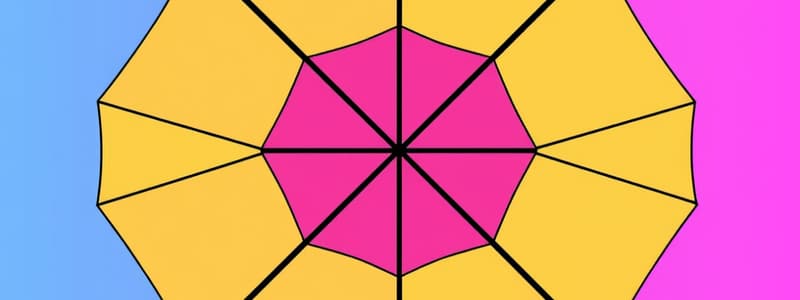Podcast
Questions and Answers
What is a ratio?
What is a ratio?
- A comparison of 2 shapes
- A comparison of 2 quantities using addition
- A type of geometric figure
- A comparison of 2 quantities using division (correct)
What are cross products?
What are cross products?
- The differences of the extremes and the means
- The products of the extremes and the means (correct)
- The sums of the extremes and the means
- The ratios of the extremes to the means
In the proportion a/b = c/d, what are the extremes?
In the proportion a/b = c/d, what are the extremes?
a and d
In the proportion a/b = c/d, what are the means?
In the proportion a/b = c/d, what are the means?
What is a proportion?
What is a proportion?
What is a scale factor?
What is a scale factor?
Similar polygons have the same shape but not necessarily the same size.
Similar polygons have the same shape but not necessarily the same size.
What is the midsegment of a triangle?
What is the midsegment of a triangle?
What is dilation?
What is dilation?
An enlargement is a dilation with a scale factor less than 1.
An enlargement is a dilation with a scale factor less than 1.
A reduction is a dilation with a scale factor greater than 1.
A reduction is a dilation with a scale factor greater than 1.
What is a scale in geometry?
What is a scale in geometry?
What is a scale model?
What is a scale model?
What is a similarity transformation?
What is a similarity transformation?
What is an altitude in a triangle?
What is an altitude in a triangle?
What is an angle bisector?
What is an angle bisector?
What is a median in geometry?
What is a median in geometry?
Study Notes
Key Concepts of Similarity in Geometry
- Ratio: A mathematical expression comparing two quantities via division, essential for understanding proportions.
- Proportion: An equation that asserts the equality of two ratios, forming the basis for many geometric relationships.
Cross Products and Components of Proportions
- Cross Products: Products calculated from the extremes (first and last terms) and the means (middle terms) of a proportion, used to check for equivalence.
- Extremes: In the proportion a/b = c/d, the values a and d are referred to as extremes, crucial for setting up and solving proportions.
- Means: In the same proportion a/b = c/d, the values b and c are called means, playing a critical role in maintaining the equality of ratios.
Scale and Similarity in Polygons
- Scale Factor: Represents the ratio between the lengths of corresponding sides of two similar polygons, determining their relative size.
- Similar Polygons: These polygons maintain the same shape but differ in size, a core concept in understanding geometric transformations.
Triangle Properties
- Midsegment of a Triangle: A segment connecting the midpoints of two sides, indicating properties related to triangle similarity and area.
- Altitude: Defined as a line segment from a triangle’s vertex to the opposite side, forming a right angle, important for calculating area.
Transformations and Dilation
- Dilation: A transformation that scales a figure either up or down while preserving proportions, fundamental in creating similar figures.
- Enlargement: Occurs when a dilation's scale factor is greater than 1, resulting in a larger figure.
- Reduction: Happens when the scale factor of a dilation is less than 1, creating a smaller version of the original figure.
- Similarity Transformation: Involves dilations that yield figures that are similar, emphasizing proportional relationships.
Additional Geometric Terminology
- Scale: The ratio used to compare a length in a model or drawing to the actual object, key for accurate representations.
- Scale Model: A representation in which dimensions are proportional to the real object, allowing for detailed study and comparison.
- Angle Bisector: A line segment that divides an angle into two equal angles, important for angle relationships in polygons.
- Median: A line segment drawn from a vertex to the midpoint of the opposite side, essential for centroid calculations and triangle properties.
Studying That Suits You
Use AI to generate personalized quizzes and flashcards to suit your learning preferences.
Description
Test your understanding of key concepts in Geometry Chapter 7 on Similarity with these flashcards. Learn important definitions related to ratios, proportions, and the properties of similar figures through concise explanations.




